Recognition of Micro-Motion Jamming Based on Complex-Valued Convolutional Neural Network
Abstract
:1. Introduction
- To our knowledge, this is the first time to realize micro-motion jamming recognition based on artificial intelligence technology. The simulation results verified the feasibility of well-performed classification ability.
- Compared with methods based on real-valued convolutional neural network (RV-CNN), the proposed method can learn more detail features and thus improve the recognition accuracy effectively.
- Compared to the traditional feature-based micro-motion jamming signal recognition methods, the proposed CV-CNN-based method can reduce the reliance of human-based feature extraction.
2. Micro-Motion Jamming Signal Model
2.1. Modulation and Repeater Micro-Motion Jamming
2.2. Micro-Motion Scattered Wave Jamming
2.3. Pulse Convolution Micro-Motion Jamming
3. Recognition of Micro-Motion Jamming Based on CV-CNN
3.1. The Structure of CV-CNN
3.2. Signal Data Pre-Processing
4. Simulations and Results
4.1. Datasets Design
4.2. Simulation Settings
4.3. Recognition Results and Analysis
5. Discussion
6. Conclusions
Author Contributions
Funding
Institutional Review Board Statement
Informed Consent Statement
Data Availability Statement
Conflicts of Interest
References
- Spezio, A.E. Electronic warfare systems. IEEE Trans. Microwave Theory Tech. 2002, 50, 633–644. [Google Scholar] [CrossRef]
- Liu, X.W.; Zhang, Q.; Chen, Y.C.; Su, L.H.; Chen, Y.J. Task allocation optimization for multi-target ISAR imaging in radar network. IEEE Sens. J. 2018, 18, 122–132. [Google Scholar] [CrossRef]
- Zhu, F.; Luo, Y.; Zhang, Q.; Feng, Y.Q.; Bai, Y.Q. ISAR Imaging for Avian Species Identification with Frequency-Stepped Chirp Signals. IEEE Geosci. Remote Sens. Lett. 2010, 7, 151–155. [Google Scholar] [CrossRef]
- Li, W.; Yuan, Y.; Zhang, Y.; Luo, Y. Unblurring ISAR Imaging for Maneuvering Target Based on UFGAN. Remote Sens. 2022, 14, 5270. [Google Scholar] [CrossRef]
- Zhou, Z.; Liu, L.; Du, R.; Zhou, F. Three-Dimensional Geometry Reconstruction Method for Slowly Rotating Space Targets Utilizing ISAR Image Sequence. Remote Sens. 2022, 14, 1144. [Google Scholar] [CrossRef]
- Wei, J.; Shao, S.; Ma, H.; Wang, P.; Zhang, L.; Liu, H. High-Resolution ISAR Imaging with Modified Joint Range Spatial-Variant Autofocus and Azimuth Scaling. Sensors 2020, 20, 5047. [Google Scholar] [CrossRef]
- Zeng, C.; Qin, M.; Li, D.; Liu, H.; Chai, Y. An Efficient ISAR Imaging of Targets with Complex Motions Based on a Quasi-Time-Frequency Analysis Bilinear Coherent Algorithm. Sensors 2018, 18, 2814. [Google Scholar] [CrossRef] [Green Version]
- Luo, Y.; Zhang, Q.; Qiu, C.W.; Liang, X.J.; Li, K.M. Micro-Doppler Effect Analysis and Feature Extraction in ISAR Imaging with Stepped-Frequency Chirp Signals. IEEE Trans. Geosci. Remote Sens. 2010, 48, 2087–2098. [Google Scholar]
- Wang, Z.H.; Chen, Y.J.; Yuan, H.; Luo, Y.; Zhang, Q. Real Micro-Doppler Parameters Extraction of Spinning Targets Based on Rotating Interference Antenna. Remote Sens. 2022, 14, 5300. [Google Scholar] [CrossRef]
- Zhu, N.; Hu, J.; Xu, S.; Wu, W.; Zhang, Y.; Chen, Z. Micro-Motion Parameter Extraction for Ballistic Missile with Wideband Radar Using Improved Ensemble EMD Method. Remote Sens. 2021, 13, 3545. [Google Scholar] [CrossRef]
- Bu, L.; Zhu, Y.; Chen, Y.; Song, X.; Yang, Y.; Zang, Y. Micro-Motion Parameter Extraction of Multi-Scattering-Point Target Based on Vortex Electromagnetic Wave Radar. Remote Sens. 2022, 14, 5908. [Google Scholar] [CrossRef]
- Qin, X.; Deng, B.; Wang, H. Micro-Doppler Feature Extraction of Rotating Structures of Aircraft Targets with Terahertz Radar. Remote Sens. 2022, 14, 3856. [Google Scholar] [CrossRef]
- Peng, S.R.; Liu, Q.; Li, X.; Tang, Z.Y. Effect Analysis of Noise FM Jamming against ISAR. Mod. Radar 2008, 30, 33–40. [Google Scholar]
- Cui, R.; Xue, L. Influence Analysis of Noise Barrage Jamming on Inverse Synthetic Aperture Radar Imaging. Mod. Def. Technol. 2008, 36, 92–98. [Google Scholar]
- Pace, P.E.; Fouts, D.J.; Ekestorm, S.R.; Karow, C. Digital False-Target Image Synthesizer for Countering ISAR. IEE Proc. Radar Sonar Navig. 2002, 149, 248–257. [Google Scholar] [CrossRef]
- Fouts, D.J.; Pace, P.E.; Karow, C. A Single-Chip False Target Radar Image Generator for Countering Wideband Image Radars. IEEE J. Solid-State Circuits 2001, 37, 751–759. [Google Scholar] [CrossRef]
- Bai, X.R.; Xing, M.D.; Zhou, F.; Lu, G.Y.; Bao, Z. Imaging of Micromotion Targets with Rotating Parts Based on Empirical-Mode Decomposition. IEEE Trans. Geosci. Remote Sens. 2008, 46, 3514–3522. [Google Scholar] [CrossRef]
- Zhu, B.Y.; Xue, L.; Bi, D.P. A Micro-motion Jamming Method to ISAR Based on Digital Image Synthesiser. Fire Control. Command Control 2012, 37, 35–38. [Google Scholar]
- Zhu, B.Y.; Xue, L.; Bi, D.P. A Micro-motion Feature Deception Jamming Method to ISAR. In Proceedings of the IEEE 10th International Conference on Signal Processing, Beijing, China, 24–28 October 2010; pp. 2287–2290. [Google Scholar]
- Shi, X.R.; Zhou, F.; Liu, L. Micro-Doppler Deception Jamming for Tracked Vehicles. In Proceedings of the 2018 IEEE International Geoscience and Remote Sensing Symposium, Valencia, Spain, 22–27 July 2018; pp. 609–612. [Google Scholar]
- Tang, Z.Z.; Dong, C.X.; Chang, X.; Liu, M.M.; Zhao, G.Q. ISAR Micro-Doppler Scatter-Wave Jamming Method Based on Towed Jammer. Acta Aeronaut. Astronaut. Sin. 2018, 39, 185–191. [Google Scholar]
- Tang, Z.Z. Study on Countermeasures against ISAR Based on Micro-Doppler Effect. Ph.D. Thesis, Xidian University, Xi’an, China, March 2019. [Google Scholar]
- Li, J.X.; Shen, Q.; Yan, H. Signal feature analysis and experimental verification of radar deception jamming. In Proceedings of the 2011 IEEE CIE International Conference on Radar, Chengdu, China, 24–27 October 2011; pp. 230–233. [Google Scholar]
- Tian, X.; Tang, B.; Gui, G. Product Spectrum Matrix Feature Extraction and Recognition of Radar Deception Jamming. Int. J. Electron. 2013, 100, 1621–1629. [Google Scholar] [CrossRef]
- Zhou, H.; Dong, C.; Wu, R.; Xu, X.; Guo, Z. Feature Fusion Based on Bayesian Decision Theory for Radar Deception Jamming Recognition. IEEE Access 2021, 9, 16296–16304. [Google Scholar] [CrossRef]
- Du, C.; Tang, B. Novel Unconventional-Active-Jamming Recognition Method for Wideband Radars Based on Visibility Graphs. Sensors 2019, 19, 2344. [Google Scholar] [CrossRef] [PubMed] [Green Version]
- Wang, Y.; Sun, B.; Wang, N. Recognition of Radar Active-Jamming Through Convolutional Neural Networks. J. Eng. 2019, 21, 7695–7697. [Google Scholar] [CrossRef]
- Shao, G.; Chen, Y.; Wei, Y. Convolutional neural network-based radar jamming signal classification with sufficient and limited samples. IEEE Access 2020, 8, 80588–80598. [Google Scholar] [CrossRef]
- Qu, Q.; Wei, S.; Liu, S.; Liang, J.; Shi, J. JRNet: Jamming Recognition Networks for Radar Compound Suppression Jamming Signals. IEEE Trans. Veh. Technol. 2020, 69, 15035–15045. [Google Scholar] [CrossRef]
- Zhou, Y.; Shang, S.; Song, X.; Zhang, S.; You, T.; Zhang, L. Intelligent Radar Jamming Recognition in Open Set Environment Based on Deep Learning Networks. Remote Sens. 2022, 14, 6220. [Google Scholar] [CrossRef]
- Hou, Y.; Ren, H.; Lv, Q.; Wu, L.; Yang, X.; Quan, Y. Radar-Jamming Classification in the Event of Insufficient Samples Using Transfer Learning. Symmetry 2022, 14, 2318. [Google Scholar] [CrossRef]
- Shen, J.; Li, Y.; Zhu, Y.; Wan, L. Cooperative Multi-Node Jamming Recognition Method Based on Deep Residual Network. Electronics 2022, 11, 3280. [Google Scholar] [CrossRef]
- Lang, B.; Gong, J. JR-TFViT: A Lightweight Efficient Radar Jamming Recognition Network Based on Global Representation of the Time–Frequency Domain. Electronics 2022, 11, 2794. [Google Scholar] [CrossRef]
- Qiu, L.; Fan, Y.Z. A Radar Jamming Recognition Method based on Hybrid Dilated Convolution. In Proceedings of the 3rd International Conference on Computer Vision, Image and Deep Learning & International Conference on Computer Engineering and Applications, Changchun, China, 20–22 May 2022; pp. 692–695. [Google Scholar]
- Kong, Y.K.; Wang, X.; Wu, C.X.; Yu, X.X.; Cui, G.L. Active Deception Jamming Recognition in the Presence of Extended Target. IEEE Geosci. Remote Sens. Lett. 2022, 19, 1–5. [Google Scholar] [CrossRef]
- Zhang, Z.M.; Wang, H.P.; Feng, X.; Ya, Q.J. Complex-Valued Convolutional Neural Network and Its Application in Polarimetric SAR Image Classification. IEEE Trans. Geosci. Remote Sens. 2017, 55, 7177–7188. [Google Scholar] [CrossRef]
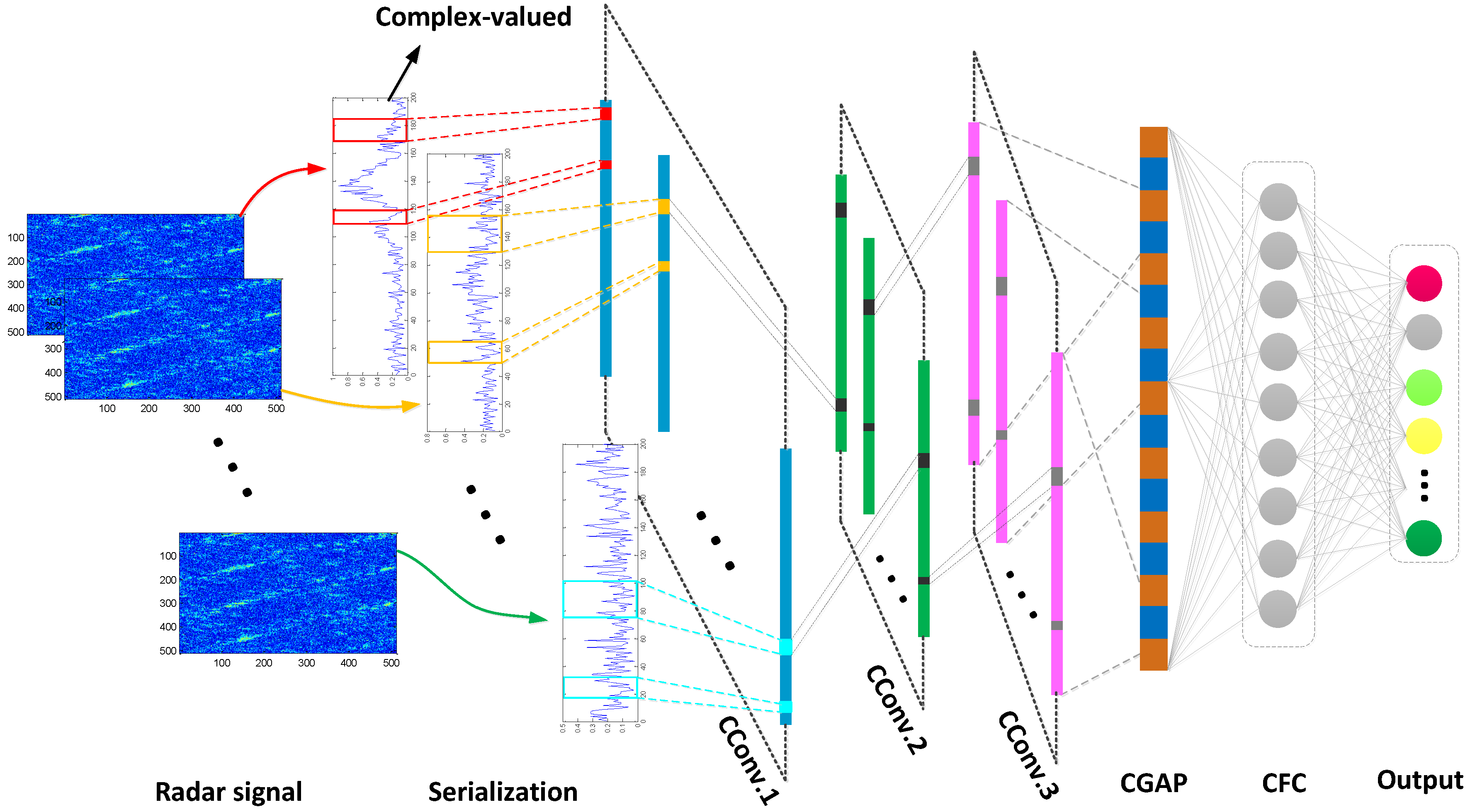
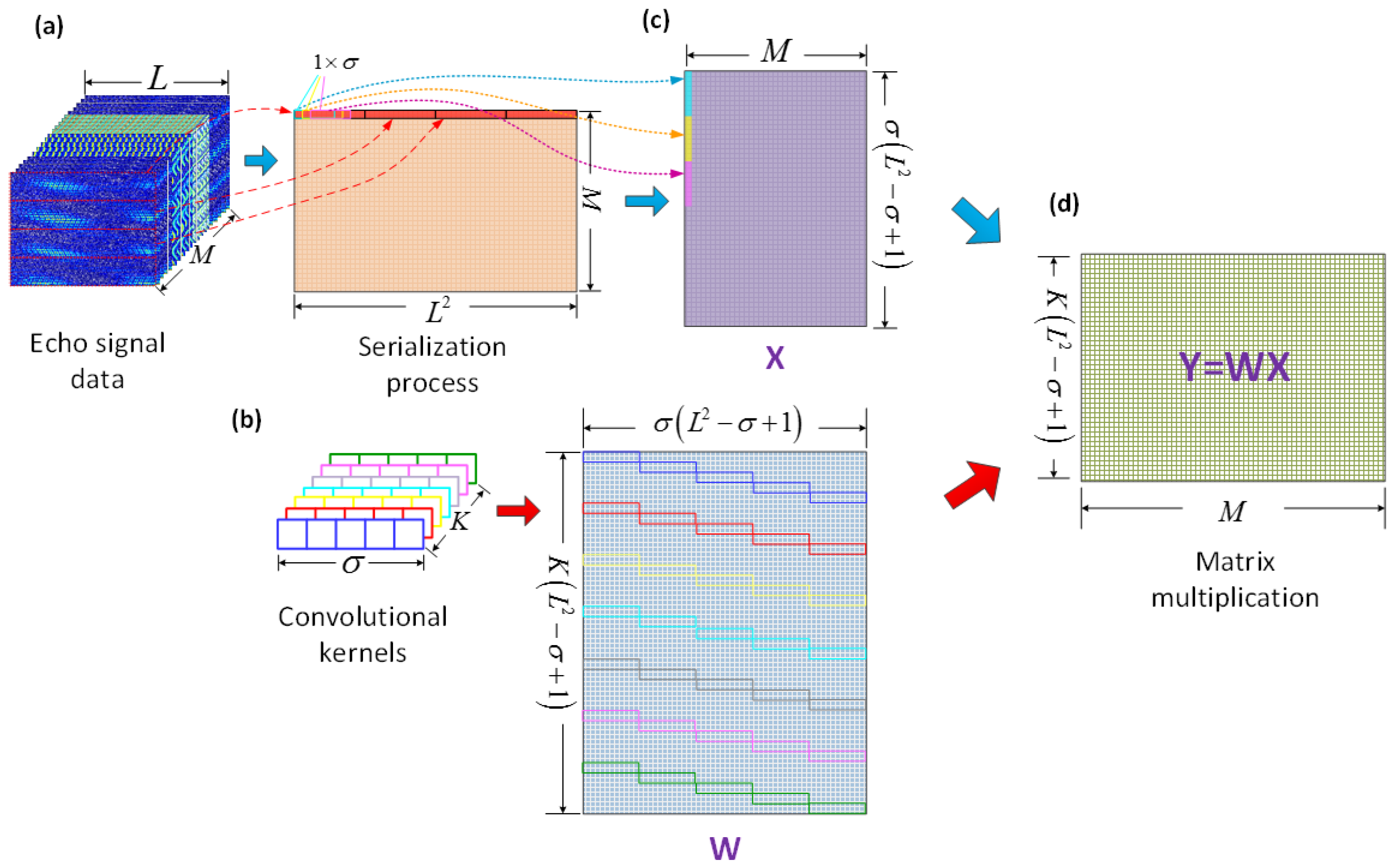
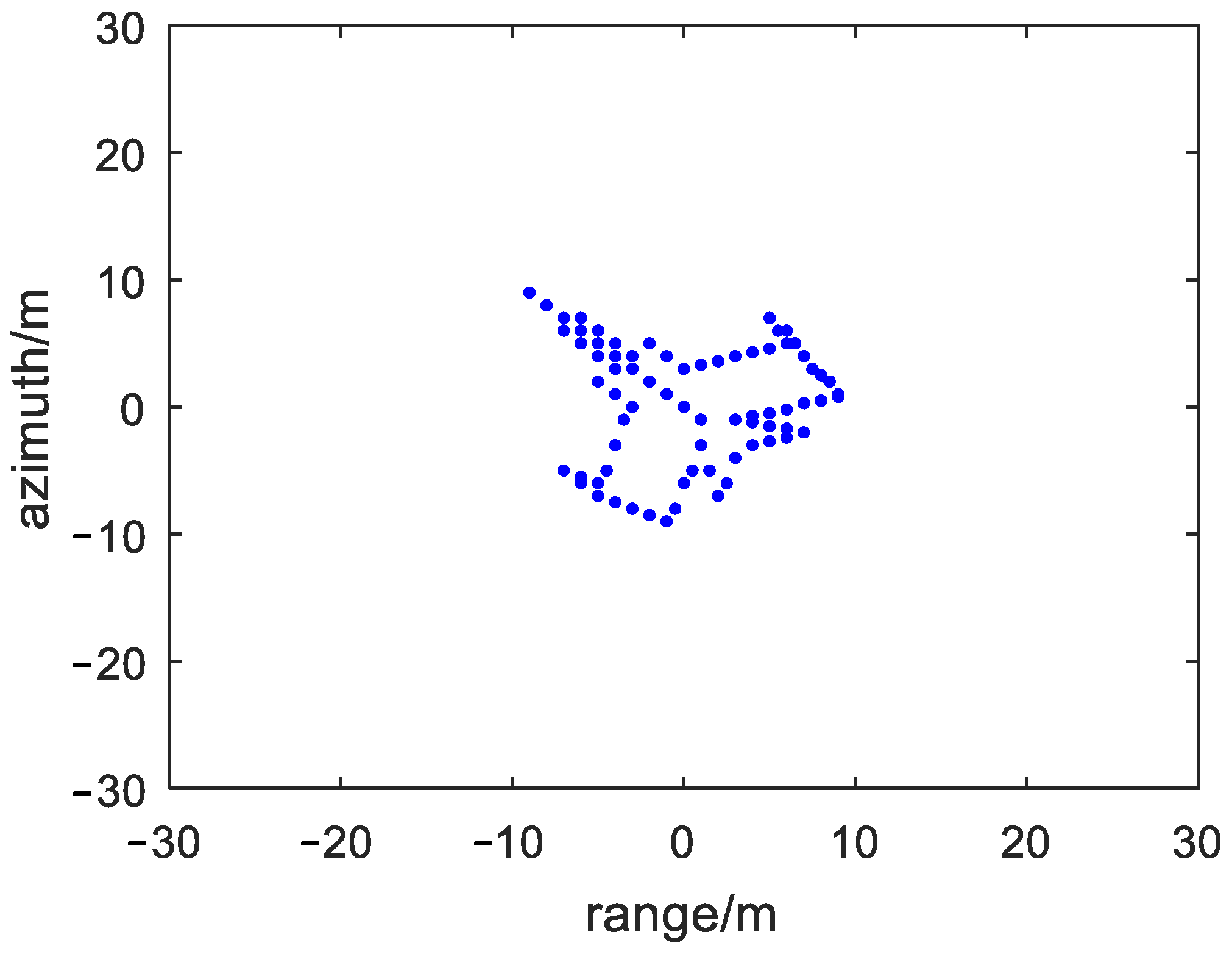





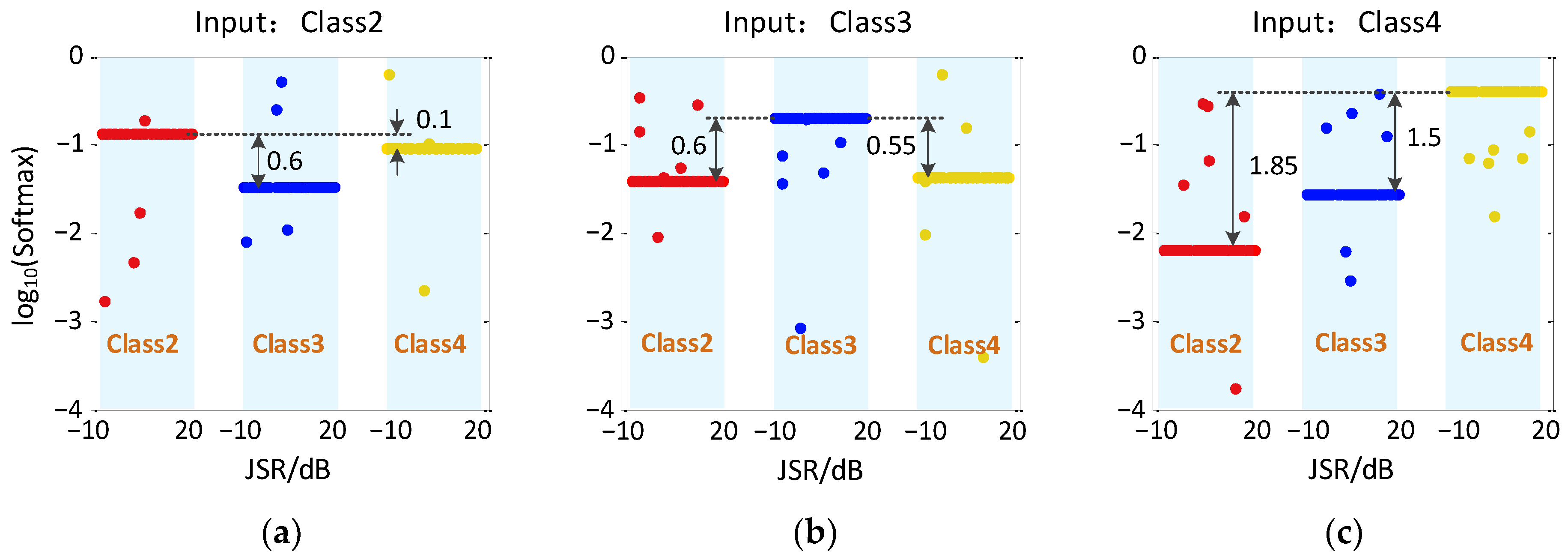
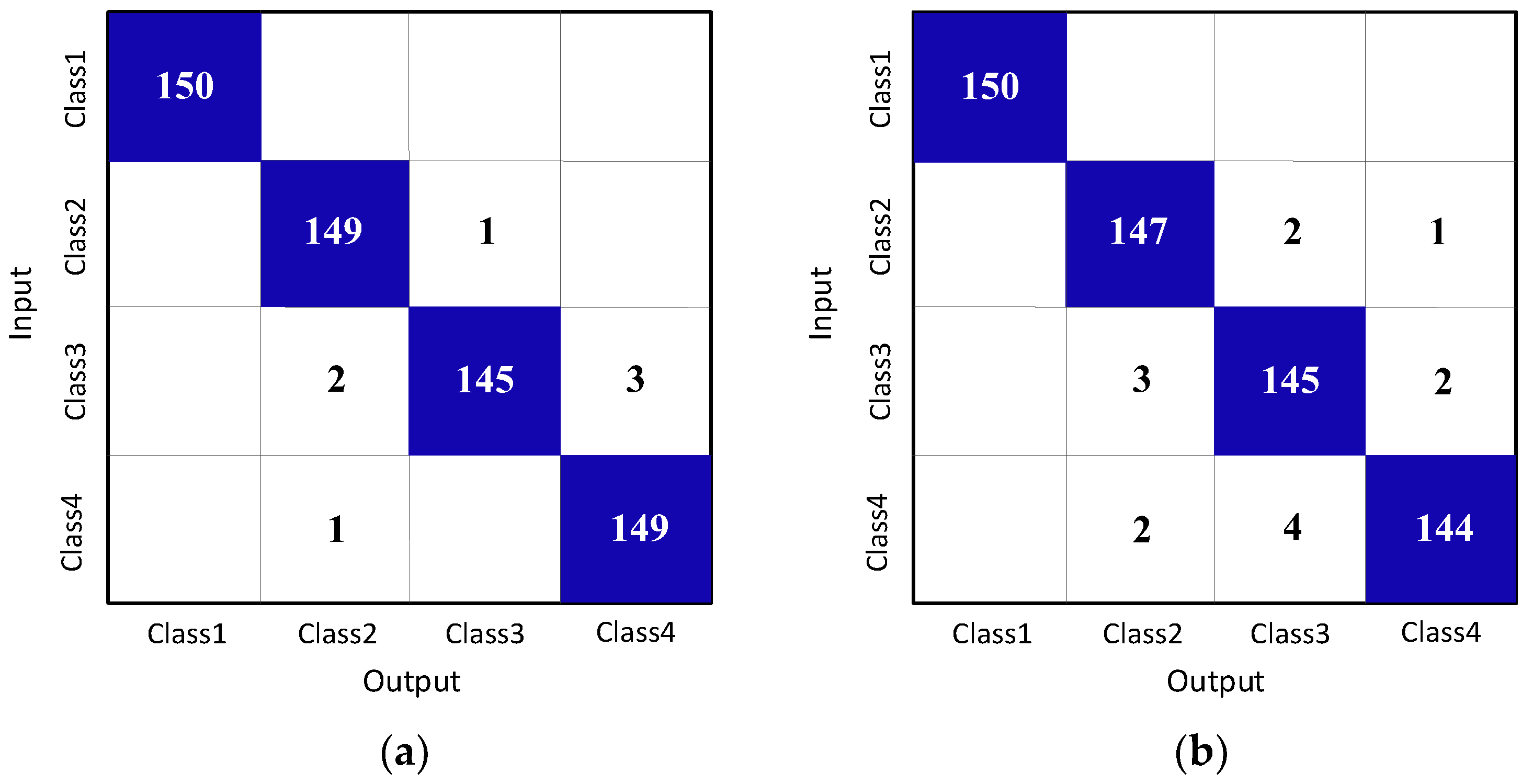
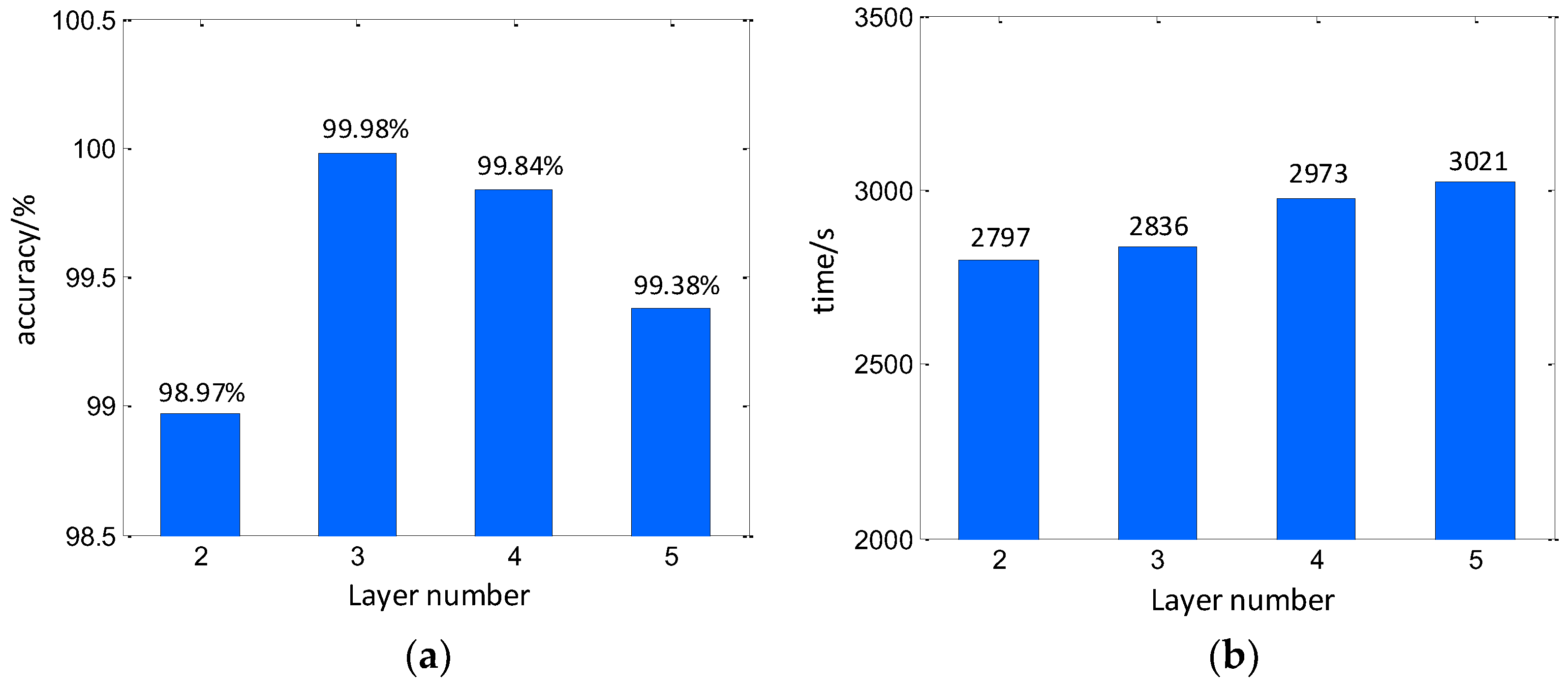
| Jamming Patterns | Main Parameters | Range of Values |
|---|---|---|
| modulation and repeater micro-motion jamming | (m) | 5~10 |
| (rad/s) | 10~20 | |
| forwarding times | 2~4 | |
| micro-motion scattered wave jamming | (m) | 5~10 |
| (rad/s) | 10~20 | |
| (rad) | 0~π | |
| forwarding times | 2~4 | |
| pulse convolution micro-motion jamming | (ns) | 0~90 |
| time delay interval (ns) | 1~5 | |
| time delay range cells | 1~7 | |
| forwarding times | 2~4 |
| Layer Name | Main Parameters | ||||
|---|---|---|---|---|---|
| Normalization Layer | Batch Normalization | ||||
| Convolution Layer | Conv. Num | Conv. Parameters | Activation | Pooling | Dropout |
| Conv. 1 | Kernel size: 5 Input num: 1 Output num: 16 | ReLU | MaxPooling (2 × 2) | - | |
| Conv. 2 | Kernel size: 7 Input num: 16 Output num: 32 | ReLU | MaxPooling (2 × 2) | - | |
| Conv. 3 | Kernel size: 9 Input num: 32 Output num: 64 | ReLU | MaxPooling (2 × 2) | 50% | |
| Global Pooling Layer | Adaptive averaging pooling processing | ||||
| Fully Connected Layer | Input num: 64 Output num: 4 | ||||
| Output Layer | Softmax | ||||
| Layer Name | Main Parameters | ||||
|---|---|---|---|---|---|
| Normalization Layer | Complex Batch Normalization | ||||
| Convolution Layer | Conv. Num | Conv. Parameters | Activation | Pooling | Complex Dropout |
| CConv. 1 | Kernel size: 5 Input num: 1 Output num: 16 | modReLU | CMaxPooling (2 × 2) | - | |
| CConv. 2 | Kernel size: 7 Input num: 16 Output num: 32 | modReLU | CMaxPooling (2 × 2) | - | |
| CConv. 3 | Kernel size: 9 Input num: 32 Output num: 64 | modReLU | CMaxPooling (2 × 2) | 50% | |
| Global Pooling Layer | Adaptive averaging pooling processing | ||||
| Complex Fully Connected Layer | Input num: 64 Output num: 4 | ||||
| Output Layer | Softmax | ||||
| Signal Pattern | CV-CNN | RV-CNN | ||
|---|---|---|---|---|
| Recognition Accuracy (%) | Probability Distance | Recognition Accuracy (%) | Probability Distance | |
| Class1 | 100 | - | 100 | - |
| Class2 | 99.33 | 12~14.9 | 98 | 0.1~0.6 |
| Class3 | 96.67 | 1~10 | 96.67 | 0.55~0.6 |
| Class4 | 99.33 | 4.5~8 | 96 | 1.5~1.85 |
| Number of Samples for Each Signal Pattern | Recognition Accuracy (%) | ||
|---|---|---|---|
| SNR = −5 dB | SNR = 0 dB | SNR = 5 dB | |
| N = 50 | 88.96 | 96.04 | 96.89 |
| N = 100 | 90.28 | 96.55 | 97.43 |
| N = 150 | 91.17 | 97.36 | 99 |
| N = 200 | 95.13 | 98.28 | 99.57 |
| N = 250 | 96.9 | 98.91 | 99.85 |
| N = 300 | 97.37 | 99.15 | 99.98 |
| Hyperparameter | Variation Range | Recognition Accuracy (%) | ||
|---|---|---|---|---|
| Epoch = 2 | Epoch = 5 | Epoch = 10 | ||
| learning rate | [5 × 10−5, 5 × 10−3] | 98.93 | 99.23 | 99.86 |
| [1 × 10−4, 1 × 10−2] | 98.56 | 98.99 | 99.23 | |
| [5 × 10−4, 5 × 10−2] | 85.5 | 95.13 | 98.87 | |
| [1 × 10−3, 1 × 10−1] | 38.37 | 68.22 | 86.57 | |
| batch size | BZ = 4 | 67.5 | 92.33 | 96.12 |
| BZ = 10 | 81.5 | 96.37 | 98.22 | |
| BZ = 15 | 96.5 | 97.86 | 99.51 | |
| BZ = 20 | 97.5 | 99.21 | 99.72 | |
| kernel number | (16, 32, 64) | 100 | 100 | 100 |
| (32, 64, 128) | 99.92 | 99.86 | 100 | |
| (64, 128, 256) | 99.88 | 98.67 | 100 | |
| (128, 256, 512) | 98.65 | 99.12 | 100 | |
Disclaimer/Publisher’s Note: The statements, opinions and data contained in all publications are solely those of the individual author(s) and contributor(s) and not of MDPI and/or the editor(s). MDPI and/or the editor(s) disclaim responsibility for any injury to people or property resulting from any ideas, methods, instructions or products referred to in the content. |
© 2023 by the authors. Licensee MDPI, Basel, Switzerland. This article is an open access article distributed under the terms and conditions of the Creative Commons Attribution (CC BY) license (https://creativecommons.org/licenses/by/4.0/).
Share and Cite
Shi, C.; Zhang, Q.; Lin, T.; Liu, Z.; Li, S. Recognition of Micro-Motion Jamming Based on Complex-Valued Convolutional Neural Network. Sensors 2023, 23, 1118. https://doi.org/10.3390/s23031118
Shi C, Zhang Q, Lin T, Liu Z, Li S. Recognition of Micro-Motion Jamming Based on Complex-Valued Convolutional Neural Network. Sensors. 2023; 23(3):1118. https://doi.org/10.3390/s23031118
Chicago/Turabian StyleShi, Chongwei, Qun Zhang, Tao Lin, Zhidong Liu, and Shiliang Li. 2023. "Recognition of Micro-Motion Jamming Based on Complex-Valued Convolutional Neural Network" Sensors 23, no. 3: 1118. https://doi.org/10.3390/s23031118
APA StyleShi, C., Zhang, Q., Lin, T., Liu, Z., & Li, S. (2023). Recognition of Micro-Motion Jamming Based on Complex-Valued Convolutional Neural Network. Sensors, 23(3), 1118. https://doi.org/10.3390/s23031118






